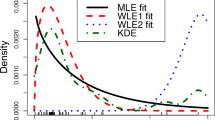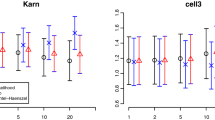Summary
In survival analysis the Kaplan Meier estimator (Kaplan and Meier, 1958) is widely used to provide information about the covariates effect on a response. Whenever a competing risks framework is given, the Kaplan Meier estimator may overstimate or underestimate the effect of the covariates (Di Serio, 1997) due to the unrealistic underlying independence assumptions. The cumulative incidence curve (CIC) is suggested as alternative estimator in these frameworks. Results deriving from the use of the CIC applied to esophageal cancer data show how this alternative tool is an intuitive as the Kaplan Meier estimator and does not required any further statistical assumptions for identifiability.
Similar content being viewed by others
References
Aalen, O. O. (1975),Statistical Inference for a family of counting processes, Ph. D. thesis, University of California, Berkeley.
Andersen, P. K., Borgan, O., Gill, R. D. andKeiding, N. (1993),Statistical Models Based on Counting Processes. New York: Springer-Verlag.
Basu, A. P. andGhosh, J. K. (1980), Identifiability of distributions under competing risks and complementary risks model,Comm. Statist.-Theor. Meth., A9 (14), 1515–1525.
Cheng, S. C., Fine, P. andWei, L. J. (1997), Prediction of Cumulative Incidence Function under the Proportional Hazard Mosel,mimeo.
Cox, D. R. (1959), The analysis of exponentially distributed life times with two types offailure.J. Royal Statist. Soc., B, 21, 411–421.
Cox, D. R. andOakes, D. (1984),Analysis of Survival Data. London: Chapman & Hall.
Di Serio, C. (1997), The Protective Impact of a Covariate on Competing Failures with an Example from a Bone Marrow Transplantation Study.Lifetime Data Analysis, 3, 99–112.
Di Serio, C., Marks, L. andParmigiani, G. (1999), The effect of Surgery in Esophageal Cancer.ISDS discussion series 99-09, Duke University.
Doob, J. L. (1953),Stochastic Processes. New York: Wiley.
Elandt-Johnson, R. C. andJohnson, N. (1980),Survival Models and Data Analysis. New York: Wiley.
Elandt-Johnson, R. C. (1984), Analysis of Distributional Patterns of Deaths from Different Causes.Scand. Actuarial Journal, 157–173.
Fleming, T. R. andHarrington, T. P. (1991),Counting Processes and survival analysis. New York: Wiley.
Hoem, J. M. (1969), Purged and partial Markov chains.Skan. Aktuarietidskr., 52, 147–155.
Johansen, S. (1983), An extension of Cox’s regression model’s.Int. Statist. Rev., 5, 195–199.
Kalbfleisch, J. D. andPrentice, R. L. (1978), The Analysis of Failure Times in the Presence of Competing Risks.Biometrics, 34, 541–554.
Kalbfleisch, J. D. andPrentice, R. L. (1980),The Statistical Analysis of Failure Time Data. New York: Wiley.
Kaplan, E. L. andMeier, P. (1958), Nonparametric estimator from incomplete observations.J. Amer. Statist. Ass., 53, 457–481.
Kavanagh, B., Anscher, M., Leopold, K., Deutsch, M., Gaydica, E., Dodge, R., Allen, K., Allen, D., Staub, E. W., Montana, G., Crawford, H. andWolfe, W. (1992), Patterns of Failure Following Combined Modality Therapy for Esophageal Cancer, 1984–1990.Int. J. Radiation Oncology Biol. Phys., 24, 633–642.
Klein, J. P. andGoel, P. (1992),Survival Analysis: The State of the Art. Amsterdam: Kluwer Press.
Meyer, P. A. (1962), A decomposition theorem for supermartingales.Illinois Journ. Math., 6, 193–205.
Moeschberger, M. L. andDavid, H. A. (1971), Life tests under competing causes of failure and the theory of competing risks.Biometrics, 27, 909–933.
Nelson, W. (1969), Hazard plotting for incomplete failure data.J. Qual. Technol., 1, 27–52.
Prakasa Rao, B. L. S. (1992),Identifiability in Stochastic Models: Characterization of Probability Distributions. New York: Academic Press.
Slud, E. V. andRubinstein, L. V. (1983), Dependent Competing Risks and Summary Survival Curves.Biometrika, 70, 643–649.
Tsiatis, A. (1975), A nonidentifiability Aspect of the Problem of Competing Risks.Proc. Nat. Acad. Sci. USA, 72, 20–23.
Author information
Authors and Affiliations
Corresponding author
Rights and permissions
About this article
Cite this article
Di Serio, C. Competing risk problems with no independence assumed: Does it make a difference?. J. Ital. Statist. Soc. 9, 39–51 (2000). https://doi.org/10.1007/BF03178957
Issue Date:
DOI: https://doi.org/10.1007/BF03178957




